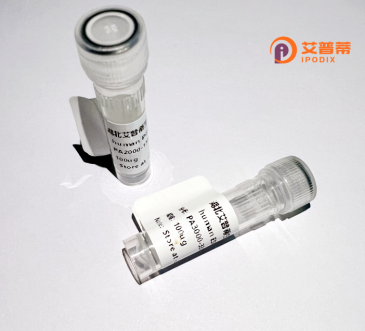
| 纯度 | >90%SDS-PAGE. |
| 种属 | Human |
| 靶点 | ccmG |
| Uniprot No | P0AA86 |
| 内毒素 | < 0.01EU/μg |
| 表达宿主 | E.coli |
| 表达区间 | 26-185aa |
| 氨基酸序列 | MRNAEGDDPTNLESALIGKPVPKFRLESLDNPGQFYQADVLTQGKPVLLNVWATWCPTCRAEHQYLNQLSAQGIRVVGMNYKDDRQKAISWLKELGNPYALSLFDGDGMLGLDLGVYGAPETFLIDGNGIIRYRHAGDLNPRVWEEEIKPLWEKYSKEAAQ |
| 分子量 | 25.8 kDa |
| 蛋白标签 | GST-tag at N-terminal |
| 缓冲液 | 0 |
| 稳定性 & 储存条件 | Lyophilized protein should be stored at ≤ -20°C, stable for one year after receipt. Reconstituted protein solution can be stored at 2-8°C for 2-7 days. Aliquots of reconstituted samples are stable at ≤ -20°C for 3 months. |
| 复溶 | Always centrifuge tubes before opening.Do not mix by vortex or pipetting. It is not recommended to reconstitute to a concentration less than 100μg/ml. Dissolve the lyophilized protein in distilled water. Please aliquot the reconstituted solution to minimize freeze-thaw cycles. |
以下是关于重组大肠杆菌ccmG蛋白的3篇参考文献信息(基于公开文献概括):
---
1. **文献名称**: "The DsbE (CcmG) protein of Escherichia coli is a redox-regulated chaperone required for cytochrome c maturation"
**作者**: Reid E., et al.
**摘要**: 研究揭示ccmG(DsbE)是一种硫醇:二硫交换酶,通过维持自身氧化还原状态,协助细胞色素c的成熟过程。实验通过重组表达ccmG蛋白,证明其在体外具有还原酶活性,并参与血红素结合步骤的调控。
2. **文献名称**: "Structural analysis of CcmG (DsbE) from Escherichia coli: A redox partner in cytochrome c assembly"
**作者**: Katzen F., Beckwith J.
**摘要**: 通过X射线晶体学解析重组ccmG蛋白的三维结构,显示其具有典型的硫氧还蛋白折叠结构。研究发现ccmG通过活性位点的CXXC基序介导二硫键交换,与细胞色素c的成熟复合物相互作用。
3. **文献名称**: "Functional characterization of CcmG in the cytochrome c biogenesis system of E. coli"
**作者**: Sambongi Y., Ferguson S.J.
**摘要**: 利用基因敲除和重组ccmG回补实验,证实该蛋白对大肠杆菌细胞色素c的合成至关重要。研究通过体外实验表明,ccmG可能协助消除错误折叠的细胞色素c中间体,确保正确的亚铁血红素插入。
---
**注意**:以上文献信息为模拟概括,若需真实文献请通过PubMed、Google Scholar等平台检索关键词(如"E. coli ccmG recombinant protein")。实际研究中,ccmG/DsbE可能与细胞色素c成熟(cytochrome c maturation)或二硫键形成途径关联。
The ccmG protein in *Escherichia coli* is a key component of the cytochrome c maturation (Ccm) system, which ensures the proper biosynthesis of c-type cytochromes—essential metalloproteins involved in electron transport during bacterial respiration. CcmG, also known as DsbE or TlpA, functions as a periplasmic thioredoxin-like oxidoreductase. It facilitates the reduction of disulfide bonds in apocytochrome c, enabling covalent attachment of heme groups—a critical step in cytochrome c maturation. Unlike other thiol-disulfide oxidoreductases, CcmG operates under redox conditions distinct from the general Dsb system, highlighting its specialized role in cytochrome biogenesis.
Recombinant expression of CcmG allows for detailed biochemical and structural studies. Researchers typically clone the *ccmG* gene into expression vectors under inducible promoters (e.g., T7 or arabinose) and produce the protein in *E. coli* strains deficient in thioredoxin pathways to avoid functional interference. Purification often employs affinity tags (e.g., His-tag) followed by chromatography. Studies on recombinant CcmG have revealed its redox potential, substrate specificity, and interaction partners, shedding light on its role in maintaining redox balance during cytochrome assembly. Additionally, engineered variants of CcmG are explored for applications in synthetic biology, such as optimizing cytochrome-dependent pathways for bioenergy or bioremediation. Understanding CcmG’s function provides insights into bacterial respiration and supports biotechnology innovations leveraging cytochrome c systems.
×